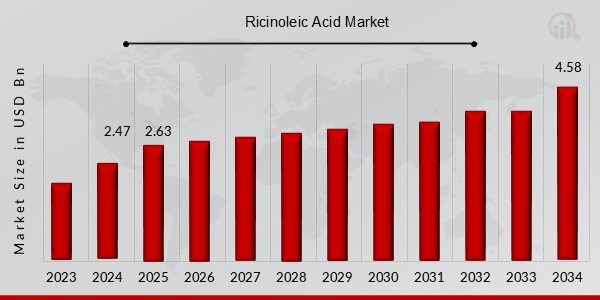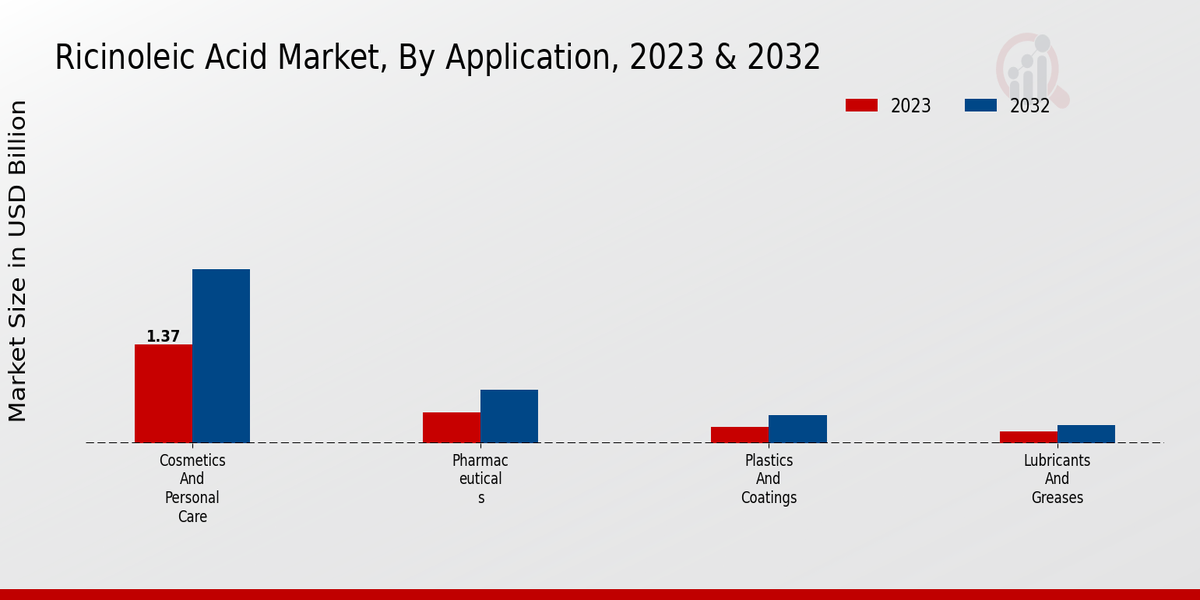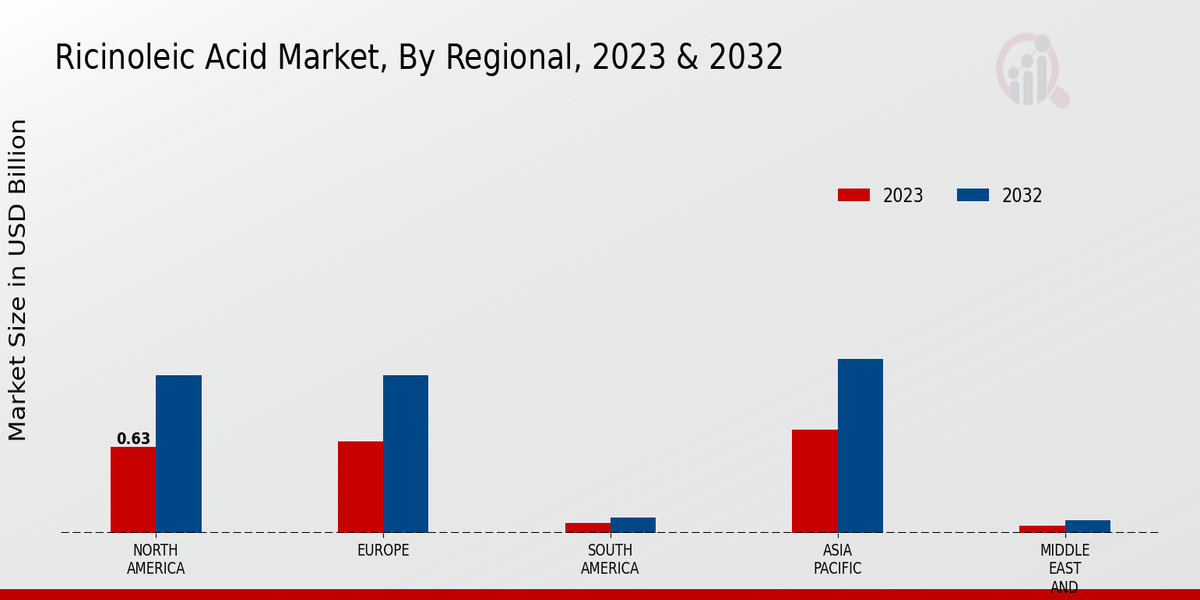Global Ricinoleic Acid Market Overview
The Ricinoleic Acid Market Size was estimated at 2.47 (USD Billion) in 2024.The Ricinoleic Acid Industry is expected to grow from 2.63(USD Billion) in 2025 to 4.58 (USD Billion) by 2034. The Ricinoleic Acid Market CAGR (growth rate) is expected to be around 6.40% during the forecast period (2025 - 2034).
Key Ricinoleic Acid Market Trends Highlighted
Updating trends from ricinoleic acid in relation to the global market indicate that more emphasis is being placed on sustainable and green products. The rising population and change in consumption patterns among consumers who are increasingly interested in natural and renewable ingredients are fueling market growth. Also, with the due progress of science and technology, processes of ricinoleic acid extraction and modification become cost-efficient and environmentally benign thanks to biotechnology and green chemistry.
Among the key factors of market expansion is the growing use of ricinoleic acid as a raw material in the manufacturing of lubricants, coatings, and cosmetics. The use of ricinoleic acid and its derivatives is growing due to the fact that the raw materials are biomass, and therefore, they are renewable. Increasing consumer demand for innovative packaging materials, and even more for products made of those materials, gives chances for expansion of the market.
Moreover, recent trends showing biobased ricinoleic acid, its esters and some vegetable oils towards performance lubes for a wider market are prevalent in the consumers' demand. Ricinoleic acid has been adopted in many industrial applications because of its exceptional characteristics, such as high lubricity. Notably, the rising popularity of organic and natural propositions in the industry is likely to boost the growth of ricinoleic acid in use as a moisturizing and skin-softening agent in skin and hair care products.

Source: Primary Research, Secondary Research, MRFR Database and Analyst Review
Ricinoleic Acid Market Drivers
Increasing Demand for Bio-based Products
With the increase in consumers' awareness of the environment and sustainability, there is a corresponding increase in the demand for bio-based materials. Ricinoleic acid, which is derived from castor oil, is one such product that is gradually gaining favor over its synthetic counterparts. This recently discovered product has unique features that are valued in different disciplines. For example, ricinoleic acid is highly viscous and has good lubricity compared to other chemicals.There is, therefore, no doubt that with the increasing number of people who are becoming aware of the environment, there will consequently be an increase in the number of people who are environmentally conscious and going for products that are bio-based.
Expansion of the Personal Care Industry
The personal care industry is a major consumer of ricinoleic acid, particularly in the production of hair care and skincare products. Ricinoleic acid's emollient properties make it an effective moisturizer and hair conditioner, contributing to the health and appearance of skin and hair. The growing demand for natural and organic personal care products has fueled the use of ricinoleic acid in this industry. Moreover, the increasing disposable income and rising awareness about personal grooming in developing countries are expected to further drive the growth of the Ricinoleic Acid Market Industry.
Technological Advancements and New Applications
Scientific research and studies that are being carried out on an ongoing basis have triggered the occurrence of new applications of ricinoleic acid. In the pharmaceutical industry, ricinoleic acid is applied as a solubilizing agent and emulsifier, at the same time facilitating the delivery or work of medicines. Similarly, as ricinoleic acid demonstrates antibacterial and antifungal properties, it may be utilized as an ingredient to develop a new generation of antimicrobial products.Finally, ricinoleic acid is also increasingly used in the production of bio-based lubricants and coatings, which help to reduce friction and wear.
Ricinoleic Acid Market Segment Insights:
Ricinoleic Acid Market Application Insights
Application Segment Insights and Overview The Ricinoleic Acid Market is segmented into various applications, including Cosmetics and Personal Care, Pharmaceuticals, Plastics and Coatings, Lubricants and Greases, and Other Industrial Applications. Among these segments, Cosmetics and Personal Care holds the largest market share due to the extensive use of Ricinoleic Acid in skincare and haircare products. Its emollient properties, which help retain moisture and improve skin texture, make it a popular ingredient in lotions, creams, and conditioners.The Pharmaceuticals segment is also a significant contributor to the Ricinoleic Acid Market, with applications in laxatives, anti-inflammatory drugs, and wound healing ointments. Ricinoleic Acid's ability to stimulate intestinal contractions and its anti-inflammatory properties make it a valuable ingredient in these formulations. Plastics and Coatings is another growing segment in the Ricinoleic Acid Market. Ricinoleic Acid is used as a plasticizer in the production of flexible plastics, and its unique properties enhance the durability and performance of coatings.In the Lubricants and Greases segment, Ricinoleic Acid finds application as a high-temperature lubricant due to its excellent thermal stability and oxidation resistance. It is used in various industrial applications, including automotive, aerospace, and manufacturing. Other Industrial Applications of Ricinoleic Acid include its use in detergents, surfactants, and textile finishing agents. Its ability to emulsify oils and fats makes it a valuable ingredient in these applications. The Ricinoleic Acid Market is expected to witness steady growth in the coming years, driven by increasing demand from the Cosmetics and Personal Care, Pharmaceuticals, and Plastics and Coatings segments.Growing awareness of the benefits of Ricinoleic Acid and the expansion of its applications are key factors contributing to the market's expansion.

Source: Primary Research, Secondary Research, MRFR Database and Analyst Review
Ricinoleic Acid Market Source Insights
The source segment of the Ricinoleic Acid Market is divided into Castor Oil and Synthetic Esterification. Castor Oil based products held a dominant share of the market in 2023. This is due to an increased demand in an array of applications across several industries such as personal care, pharmaceuticals, and lubricants. The demand for ricinoleic acid produced through synthetic esterification, however, is expected to be higher during the forecast period due to its wide application in the production of synthetic bio-based polymers and plasticizers.
Ricinoleic Acid Market Grade Insights
The Ricinoleic Acid Market is segmented by Grade into Technical Grade, Pharmaceutical Grade, and Cosmetic Grade. Among these, the Technical Grade segment held the largest market share in 2023 and is expected to continue its dominance throughout the forecast period. The growth of this segment can be attributed to the increasing demand for ricinoleic acid in the production of lubricants, plasticizers, and other industrial applications. The Pharmaceutical Grade segment is expected to witness significant growth over the forecast period due to the rising demand for ricinoleic acid in the manufacturing of pharmaceuticals and personal care products.The Cosmetic Grade segment is also anticipated to exhibit steady growth, driven by the increasing use of ricinoleic acid in cosmetics and skincare products.
Ricinoleic Acid Market Form Insights
The Ricinoleic Acid Market segmentation by Form can be divided into Liquid and Solid. Among them, the Liquid segment accounted for the largest share of the Ricinoleic Acid Market revenue in 2023, and it is expected to continue to lead the market during the forecast period. Liquid ricinoleic acid is a versatile form that finds applications in various industries, including personal care, pharmaceuticals, and lubricants. The increasing demand for liquid ricinoleic acid in cosmetics and personal care products, such as soaps, shampoos, and conditioners, is a major factor driving the growth of this segment.In 2024, the Ricinoleic Acid Market is projected to reach a value of USD 2.35 billion, with the Liquid segment contributing a significant portion to this growth.
Ricinoleic Acid Market End-Use Industry Insights
The end-use industry segment plays a crucial role in shaping the Ricinoleic Acid Market market dynamics. The automotive industry holds a significant share due to the increasing demand for bio-based lubricants and additives. In 2023, the automotive segment accounted for approximately 28.5% of the Ricinoleic Acid Market revenue, valued at USD 721.6 million. The construction industry is another major consumer, driven by the growing use of ricinoleic acid-based coatings and sealants. The electronics industry also utilizes ricinoleic acid in the production of printed circuit boards and other electronic components.The textiles industry leverages ricinoleic acid for the manufacture of eco-friendly fabrics and dyes. Finally, the food and beverage industry employs ricinoleic acid as an emulsifier and stabilizer in various food products. The market segmentation data and statistics reveal the diverse applications of ricinoleic acid across these end-use industries, highlighting the industry's growth potential and the opportunities for market participants.
Ricinoleic Acid Market Regional Insights
The regional segmentation of the Ricinoleic Acid Market offers valuable insights into the market's growth dynamics and consumption patterns. North America holds the largest market share due to high demand from the personal care and pharmaceutical industries. Europe follows closely with a significant market presence, driven by stringent regulations and a growing consumer base. APAC is projected to witness the highest growth rate over the forecast period, attributed to rising disposable incomes and increasing urbanization. South America and MEA exhibit steady growth potential, with emerging economies contributing to market expansion.Despite holding a smaller market share, these regions present promising growth opportunities for Ricinoleic Acid manufacturers targeting niche applications.

Source: Primary Research, Secondary Research, MRFR Database and Analyst Review
Ricinoleic Acid Market Key Players And Competitive Insights:
The Ricinoleic Acid Market’s major players are seen to continuously strive to develop their products and technology. In order to expand their reach and product lines, market leaders in the ricinoleic acid market focus on market development and innovation, which are driven by companies forming partnerships and strategic collaborations. Leading companies highly invest in R&D and focus on introducing advanced solutions to cater to consumers’ demands. The Ricinoleic Acid Market is estimated to observe a competitive climate, with companies’ development and the launch of new technologies and solutions that shape the competitors’ niche.Croda International Plc is a leading Ricinoleic Acid Market supplier. The firm deals in the manufacturing and supply of various specialty chemicals and ingredients. Quality and solutions innovation have seen the company become one of the best suppliers in this market. Croda International Plc owns various ricinoleic acid-derived solutions and formulations. The company’s great reputation is attributed to its excellent customer service and the quality of solutions provided.BASF SE is a notable Ricinoleic Acid Market competitor. The company is a large-scale chemical company with global reach. It owns different solutions, such as ricinoleic acid, which is part of its vast product line. The company prides itself in R&D which it focuses on to improve existing solutions and create new ones to meet the changing market. High focus on innovation and sustainability has seen it become a leading Ricinoleic Acid Market player.
Key Companies in the Ricinoleic Acid Market Include:
- Wilmar International
- Godrej
- BASF
- Cargill
- Adani Wilmar
- Jayant AgroOrganics
- Croda International
- LANXESS
- Ruchi Soya
- IOINEWparaFeixiang
- Nouryon
- Emery Oleochemicals
Ricinoleic Acid Market Industry Developments
Rising demand for bio-based products, increasing utilization in personal care and cosmetics industries, and growing adoption in food and beverage applications are major factors driving market growth. Key developments include the launch of sustainable ricinoleic acid production processes and strategic partnerships among manufacturers to expand market presence. The market is expected to witness significant growth opportunities in emerging economies due to rising disposable incomes and increasing awareness about the benefits of natural ingredients.
Ricinoleic Acid Market Segmentation Insights
- Ricinoleic Acid Market Application Outlook
- Cosmetics and Personal Care
- Pharmaceuticals
- Plastics and Coatings
- Lubricants and Greases
- Other Industrial Applications
- Ricinoleic Acid Market Source Outlook
- Castor Oil
- Synthetic Esterification
- Ricinoleic Acid Market Grade Outlook
- Technical Grade
- Pharmaceutical Grade
- Cosmetic Grade
- Ricinoleic Acid Market Form Outlook
- Ricinoleic Acid Market End-Use Industry Outlook
- Automotive
- Construction
- Electronics
- Textiles
- Food and Beverage
| Report Attribute/Metric |
Details |
| Market Size 2024 |
2.47(USD Billion) |
| Market Size 2025 |
2.63(USD Billion) |
| Market Size 2034 |
4.58(USD Billion) |
| Compound Annual Growth Rate (CAGR) |
6.40% (2025 - 2034) |
| Report Coverage |
Revenue Forecast, Competitive Landscape, Growth Factors, and Trends |
| Base Year |
2024 |
| Market Forecast Period |
2025 - 2034 |
| Historical Data |
2020 - 2024 |
| Market Forecast Units |
USD Billion |
| Key Companies Profiled |
Wilmar International, Godrej, BASF, Cargill, Adani Wilmar, Jayant AgroOrganics, Croda International, LANXESS, Ruchi Soya, IOINEWparaFeixiang, Nouryon, Emery Oleochemicals |
| Segments Covered |
Application, Source, Grade, Form, End-Use Industry, Regional |
| Key Market Opportunities |
Biodegradable Lubricants Cosmetics and Personal Care Food Additives Pharmaceuticals Industrial Applications |
| Key Market Dynamics |
Growing demand for biobased products Increasing use in personal care products Rising consumption in lubricants Expanding applications in food industry Technological advancements in production processes |
| Countries Covered |
North America, Europe, APAC, South America, MEA |
Frequently Asked Questions (FAQ) :
The Ricinoleic Acid Market is expected to be valued at approximately USD 2.63 billion in 2025 and is projected to reach USD 4.58 billion by 2034, exhibiting a CAGR of 6.40% during the forecast period.
Asia Pacific is anticipated to hold the largest market share and is projected to maintain its dominance throughout the forecast period. The growing demand for ricinoleic acid in personal care and cosmetic applications in developing countries like China and India is driving the regional market growth.
Ricinoleic acid finds applications in various industries, including personal care and cosmetics, pharmaceuticals, food additives, and lubricants. In personal care and cosmetics, it is commonly used as an emollient, moisturizer, and surfactant. In pharmaceuticals, it is utilized as a laxative and in the production of certain medications. Ricinoleic acid is also employed as a food additive and in the manufacturing of lubricants.
Some of the prominent companies operating in the Ricinoleic Acid Market include Emery Oleochemicals, J.M. Huber Corporation, Croda International Plc, Jyothy Laboratories Limited, and Shepherd Chemical Company. These companies are involved in the production, distribution, and sales of ricinoleic acid and its derivatives.
The rising demand for ricinoleic acid in personal care and cosmetic products, particularly in emerging economies, is a major factor driving market growth. Additionally, the increasing use of ricinoleic acid in pharmaceutical applications, such as laxatives and other medications, is contributing to market expansion. Furthermore, growing consumer awareness regarding the benefits of natural and sustainable ingredients is creating opportunities for ricinoleic acid in various industries.
The Ricinoleic Acid Market faces certain challenges, including fluctuations in the prices of raw materials, such as castor oil, which can impact production costs. Moreover, stringent regulations regarding the use of certain chemicals in personal care and cosmetic products may pose challenges for manufacturers. Additionally, competition from synthetic substitutes and the availability of alternative ingredients can create competitive pressures in the market.
The Ricinoleic Acid Market is witnessing a growing trend towards the use of sustainable and eco-friendly ingredients. Manufacturers are focusing on developing ricinoleic acid derivatives that are derived from renewable resources and have a lower environmental impact. Additionally, the increasing demand for natural and organic personal care products is creating opportunities for ricinoleic acid as a natural emollient and moisturizer.
The Ricinoleic Acid Market is anticipated to expand at a steady pace in the coming years, with a projected CAGR of 6.40% from 2025 to 2034. This growth is attributed to the rising demand for ricinoleic acid in various end-use industries, particularly in personal care and cosmetics, pharmaceuticals, and food additives.
The Ricinoleic Acid Market presents several key opportunities for growth. The increasing demand for natural and sustainable ingredients in personal care and cosmetic products is creating opportunities for ricinoleic acid as a natural emollient and moisturizer. Additionally, the growing pharmaceutical applications of ricinoleic acid, such as in laxatives and other medications, is expected to drive market growth. Furthermore, the expansion of the food and beverage industry, particularly in emerging economies, is creating new opportunities for ricinoleic acid as a food additive.
The Ricinoleic Acid Market faces certain challenges, including the fluctuating prices of raw materials, such as castor oil, which can impact production costs. Additionally, stringent regulations regarding the use of certain chemicals in personal care and cosmetic products may pose challenges for manufacturers. Furthermore, competition from synthetic substitutes and the availability of alternative ingredients can create competitive pressures in the market.
















